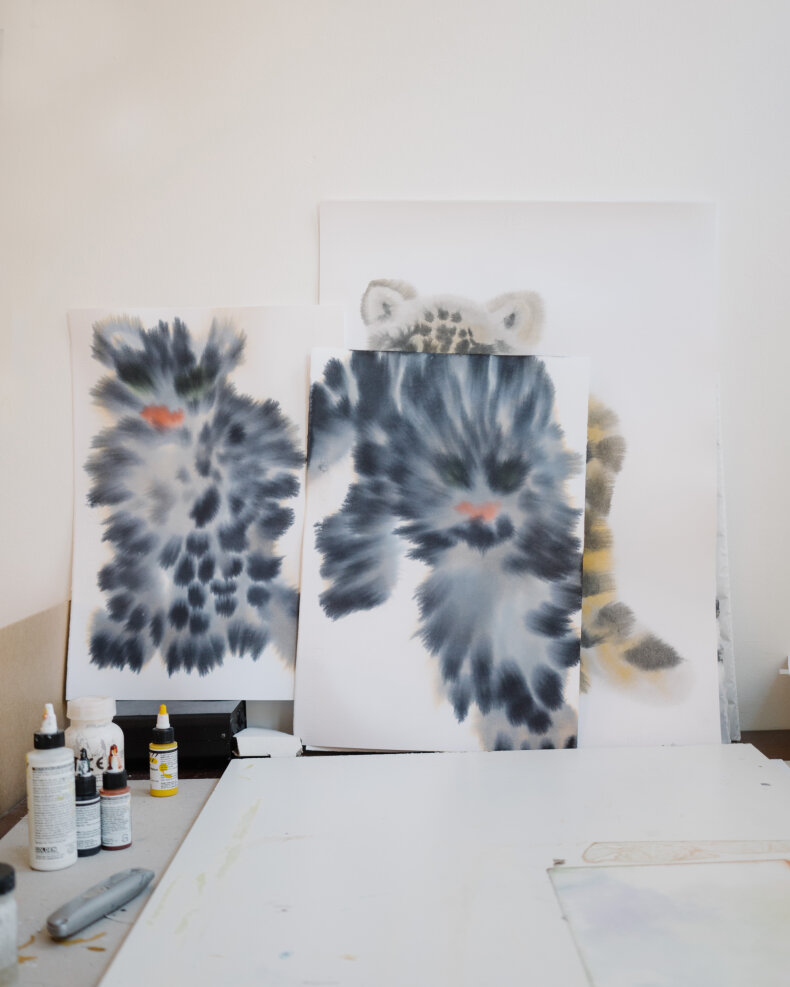-
5 QUESTIONS
ROP VAN MIERLO
-
Rop van Mierlo is an Amsterdam-based artist who specialises in wet-on-wet painting. His most famous works, dubbed Wild Animals, found themselves on a variety of surfaces from scarves with Hermès, bags with Head Porter, textiles with Marni and Pop Trading Co.
-
Finally, the artist ventured in making his own label, translating his paintings into a collection of knitwear pieces. Ahead of the release event at Norse Store Thursday 10th November 2022, Rop discusses his technique, process, intuition, and letting go.
-
Tell us about the importance of childlike wonder, both in your craft and in its interpretation.
The nice thing about the way of painting on wet paper is the letting go, and don't try to direct it in any way. That's often also the hardest part, because a lot of times you try to reach something that just doesn't happen. It's important to stay open to whatever happens, and don't judge it too much.
You've talked about being forced out of your comfort zone when you learned to paint on wet paper at a Waldorf school. When did you become comfortable with giving up control in your practice?
As a child, I drew a lot; but was also often very frustrated with it. The more I strived for perfection, the more I hated the outcome. Later it get better as I learned that a drawing that is not perfect, or far from it, often does more to me. The wet in wet technique is ultimately very liberating because I have no control over so many facets and the more I let it go, the better it gets. Therefore, the very first paintings were very good because I had no expectations and wasn't trying to reach a certain level or whatsoever.
-
How does intuition play into how you create your art?
Intuition is especially important to me in collaborating and decision making. As soon as I start weighing and deliberating I drift away from my gut feelings and often don't know anymore which choice is best. I can talk and think about a decision for days without getting anywhere. But if I trust my gut it can go in a second.
After your multiple collaborations with other brands, why did you decide to strike out on your own?
In 2019, Remco my business partner and other half of Wild Animals stepped out of his then company and asked me to work together. At first I was not interested in working together because I prefer to work alone. When we started talking together about a possible collaboration, I mainly started proposing ideas that I thought Remco wouldn't like. When he actually thought they were cool, a basis of what we are working on now slowly emerged. - But even more than a brand, I try to see Wild Animals as a place where I can realize my ideas.
-
That's one of the reasons why we don't work in seasons like the fashion industry but try to work from the ideas that are there. And release them when ready. Therefore, the offerings can really go in all directions and the rhythm is also all over the place. Lately though, we have been talking a lot about ways to simplify our way of doing, and are working towards a more steady pace of releases. Developing new products from scratch is a lot of work every time. Especially when one time it's a porcelain mug painted by hand, and the next a series of hand-knitted cardigans from Bosnia.
-
How is embroidering on knitting similar to your 'wet-on-wet' painting technique?
I think the fun part of translating my paintings into knitting is that it's kind of silly (or even dumb in a good way) to do. It's really fun to translate these abstract and blurred images, with lots of nuances, into really graphic pixelated files with only 2 to 5 colors. There really is a charm in the simplicity of the new image. The fun then is to knit it into a fuzzy material that mimics the essence of the original painting, but translated into a new product. So it is not a literal copy but becomes a copy with its own quality.








